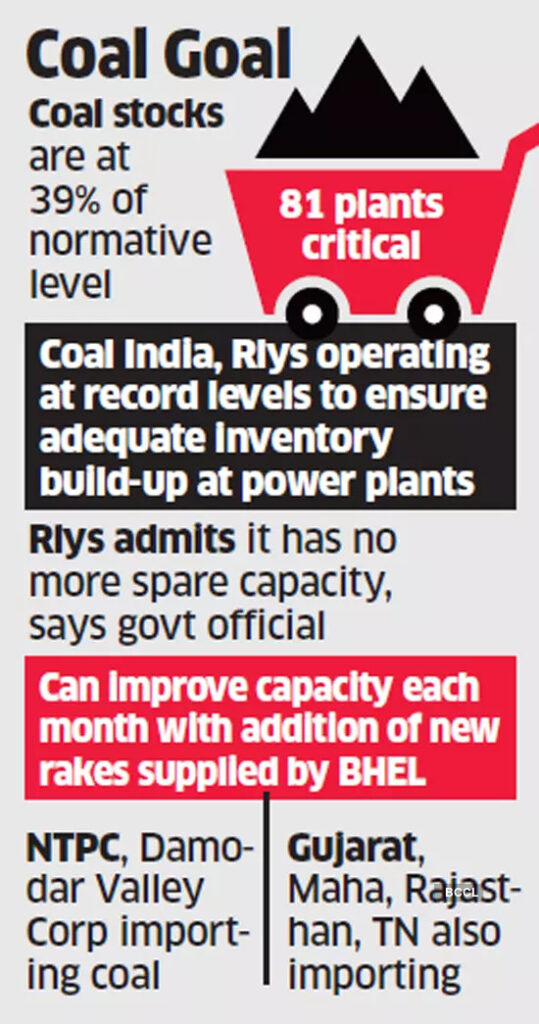Source: https://economictimes.indiatimes.com/industry/indl-goods/svs/metals-mining/mcl-becomes-the-largest-coal-producing-company-in-india/articleshow/90193546.cms
Publisher: Economic Times
The government expects a touch-and-go situation in terms of the availability of coal to power stations in the coming summer and rainy seasons even as all departments are fighting odds to prevent a crisis similar to August last year.
In a recent meeting chaired by cabinet secretary Rajiv Gauba, Indian Railways admitted that it has exhausted its rake availability capacity, people aware of the matter told.
Coal India and the railways are operating at record levels to ensure adequate inventory build-up at power plants, they said.
“Indian Railways has admitted that it is exhausted and has no more spare capacity,” a senior government official said. “It has said it can improve its capacity each month with the addition of new rakes supplied by BHEL. The overall situation remains critical.”

Railway ministry executive director (information and publicity) G K Bansal said it has improved its wagon turn round (WTR) time by 16% between September 2021 and February and is putting efforts to improve it further. Lower WTR would mean more wagons being available in a shorter period.
Central power generators NTPC and Damodar Valley Corp have begun to import coal as also states like Gujarat, Maharashtra, Rajasthan and Tamil Nadu, sources said. In a meeting last week to review inventory position at power plants, power minister R K Singh urged private power plants to begin importing 4% of coal requirement.
Coal stocks at the project heads, however, are not rising due to high consumption on the back of increased electricity demand. Record imported prices, crossing $200 per tonne, due to the Russia-Ukraine crisis has added to the pressure as 16 GW of imported coal-based capacity is either not operating or remains underutilised.
Data available with the Central Electricity Authority shows that as of March 10, coal stocks are at 39% of the normative level mandated by the recently changed norms.
A section of industry observers is critical of the new norms, saying they are too high.
Bansal said the supply of rakes to the power sector was augmented from 305 rakes per day in September to 396 rakes per day last month. During the second inter-ministerial meet on January 24, the railways were advised to provide additional 25-30 rakes per day to the power sector, following which the supply of rakes to the power sector has been improved from 373 to 405 rakes a day, he said.
Another government official said, “The coal companies have to focus on reducing the loading time at colliery sidings which are very high at some sidings. Reducing the detention of all rakes at coal sidings to 3 hours or less will generate additional empties to the tune of 3 to 4 rakes per day which can be gainfully utilised for more loading of coal.”
As many as 81 projects have critical stocks of less than 25% normative stock, including 10 imported coal projects and 9 non-operational plants.
Power stations have aggregate coal stock of 26 million tonnes, while the same at Coal India mines is at 45 million tonnes.
“Ample coal stocks are available with CIL,” a government official said. “With the gradual increase in rake availability through the acquisition programme launched by Indian Railways, the situation may ease in the later half of the current fiscal.”
Railways have a plan to induct 100,000 wagons with 40,000-45000 of them coming in the next two years. The condemnation of older wagons on an age basis has also been deferred to maintain numbers. In addition to these steps, the railways have also identified 66 critical and 58 supercritical capacity enhancement works and 14 coal evacuation projects, which are monitored at the highest level for targeted completion.

